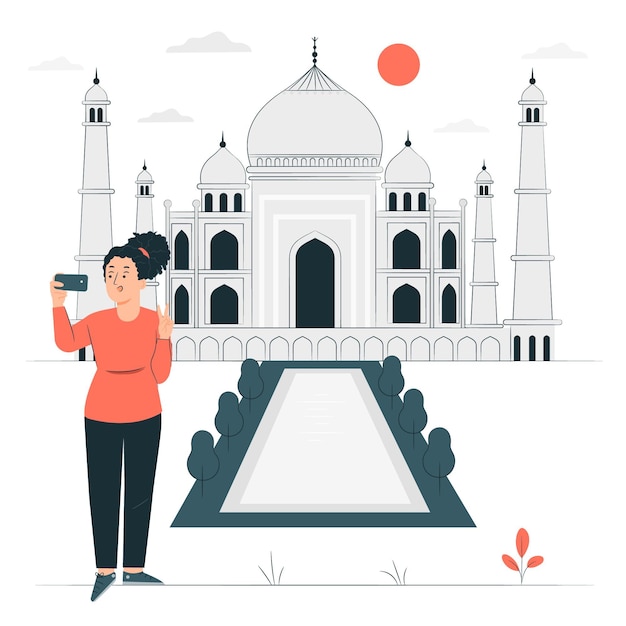Taj Mahal Facts – Discover the Astonishing Trivia Behind India’s Pristine Jewel

The Taj Mahal is a stunning symbol of eternal love.
Construction of the Taj Mahal began in 1632 and took around 20 years to complete.
The Taj Mahal is located in the city of Agra, in the northern state of Uttar Pradesh, India.
The Taj Mahal was built by Mughal Emperor Shah Jahan in memory of his beloved wife, Mumtaz Mahal.
It is considered to be one of the most beautiful buildings in the world.
The Taj Mahal is made entirely of white marble.
It is estimated that over 1,000 elephants were used to transport the construction materials for the Taj Mahal.
The main dome of the Taj Mahal stands at a height of 240 feet (73 meters).
The four minarets surrounding the main structure were constructed slightly tilted outward to protect the main tomb in the event of an earthquake.
The Taj Mahal complex is a UNESCO World Heritage Site.
The gardens surrounding the Taj Mahal are known as the Charbagh, which is a Persian-style garden.
The Taj Mahal attracts millions of visitors from around the world each year.
The construction of the Taj Mahal cost an estimated 32 million rupees, which would be equivalent to around 1 billion dollars today.
The Taj Mahal changes color at different times of the day depending on the lighting conditions.
The white marble used in the construction of the Taj Mahal was sourced from various parts of India and other countries, including China and Afghanistan.
The Taj Mahal was designed by Ustad Ahmad Lahauri, a Persian architect.
Taj Mahal Facts – Discover the Astonishing Trivia Behind India’s Pristine Jewel part 2
The main tomb inside the Taj Mahal houses the cenotaphs of Mumtaz Mahal and Shah Jahan.
The actual graves of Mumtaz Mahal and Shah Jahan are located in a lower level chamber beneath the main tomb, which is not open to the public.
The interior of the Taj Mahal is adorned with intricate carvings, inlaid gems, and calligraphy.
The Taj Mahal was inscribed as a UNESCO World Heritage Site in 1983.
The Taj Mahal is often cited as the pinnacle of Mughal architecture.
The symmetrical layout of the Taj Mahal represents the balance and harmony that is valued in Islamic architecture.
The Taj Mahal is best seen during sunrise or sunset when the changing light accentuates its beauty.
The reflection of the Taj Mahal in the adjacent Yamuna River adds to its ethereal charm.
The construction of the Taj Mahal involved the employment of over 20,000 workers, including architects, artisans, and laborers.
The Quranic inscriptions on the Taj Mahal are said to be among the most intricate and elaborate in the world.
The Taj Mahal is a source of national pride for the people of India.
Several legends and myths are associated with the Taj Mahal, adding to its mystique.
The Taj Mahal complex includes a mosque, a guest house, and other structures.
The Taj Mahal is said to look different from each of its four sides, presenting a unique view from every angle.
The construction of the Taj Mahal was funded through the empire’s treasury.
The Taj Mahal is often referred to as a teardrop on the cheek of eternity.
The monument faces the east, which is significant in Islamic tradition as it symbolizes the direction of prayer.
The Taj Mahal was almost destroyed during the Indian Rebellion of 1857, but it was saved by Lord Curzon, the Viceroy of India at the time.
The Taj Mahal was designated as a UNESCO World Heritage Site for its cultural significance.
The Taj Mahal is considered one of the finest examples of Mughal architecture.
The construction of the Taj Mahal required the use of bricks made from clay brought from across the Indian subcontinent.
The Taj Mahal’s minarets were built intentionally tilted outward to reduce the impact of earthquakes.
The Taj Mahal’s facade is decorated with verses from the Quran written in calligraphy.
The Taj Mahal complex is surrounded by a large wall made of red sandstone.
The Taj Mahal’s construction materials were transported by carts pulled by oxen.
The Taj Mahal was designed to be a symmetrical and balanced structure in all respects.
The gardens surrounding the Taj Mahal are meticulously maintained and are a key part of its overall beauty.
The Taj Mahal is not just a monument; it is a symbol of undying love and devotion.
The Taj Mahal’s timeless beauty continues to inspire artists, poets, and travelers from all walks of life.

